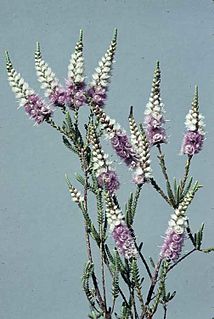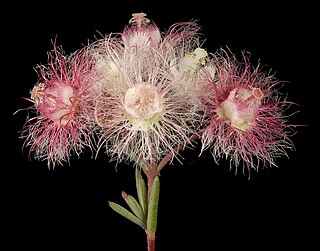Verticordia aereiflora is a flowering plant in the myrtle family, Myrtaceae and is endemic to the south-west of Western Australia. It is a thin but bushy shrub with small leaves and greenish-yellow flowers with red spots and red fringes on the sepals.
Verticordia attenuata is a flowering plant in the myrtle family, Myrtaceae and is endemic to the south-west of Western Australia. It is a shrub with a single main stem, small leaves and pink to purple flowers which fade to white as they age. It usually grows in sand in areas that are wet in winter, often amongst grasses and is found in coastal areas near Bunbury.
Verticordia auriculata is a flowering plant in the myrtle family, Myrtaceae and is endemic to the south-west of Western Australia. It is a small, multi-branched shrub with small leaves and spikes of pink to magenta-coloured flowers in late spring to early summer and it is widespread in the wheatbelt.

Verticordia halophila, commonly known as salt-loving featherflower, or salt-loving verticordia, is a flowering plant in the myrtle family, Myrtaceae and is endemic to the south-west of Western Australia. It is an erect, bushy shrub with small, crowded, thick leaves and spikes of red and pink flowers in spring.

Verticordia spicata, commonly known as spiked featherflower, is a flowering plant in the myrtle family, Myrtaceae and is endemic to the south-west of Western Australia. It is usually a dense, bushy shrub with small leaves pressed against the stem and spikes of pink flowers from late spring to early summer.

Verticordia venusta is a flowering plant in the myrtle family, Myrtaceae and is endemic to the south-west of Western Australia. It is an openly branched shrub with small, egg-shaped leaves and spikes of pink to maroon-coloured flowers in spring and early summer.
Verticordia centipeda is a flowering plant in the myrtle family, Myrtaceae and is endemic to the south-west of Western Australia. It is a shrub with a single stem at the base, small crowded leaves and greenish-pink flowers with a silvery fringe, in spike-like groups on the ends of the branches. It is common in areas around Geraldton.
Verticordia dasystylis is a flowering plant in the myrtle family, Myrtaceae and is endemic to the south-west of Western Australia. It is a small shrub, with many stems at its base, oblong leaves and scented, fluffy, yellow and white flowers. There are three subspecies, each of which has a priority conservation status.
Verticordia densiflora var. cespitosa is a flowering plant in the myrtle family, Myrtaceae and is endemic to the south-west of Western Australia. It is a shrub with small leaves and pink, or pink and white flowers. It is one of five varieties of the species Verticordia densiflora.

Verticordia huegelii var. huegelii, commonly known as variegated featherflower, is a flowering plant in the myrtle family, Myrtaceae and is endemic to the south-west of Western Australia. It is an upright, slender or bushy shrub, with creamish-white flowers turning pink or reddish maroon as they age, giving the plant a variegated appearance. It is similar to Verticordia huegelii var. decumbens but is more upright than that variety and lacks a lignotuber.

Verticordia laciniata is a flowering plant in the myrtle family, Myrtaceae and is endemic to the south-west of Western Australia. It is an openly branched shrub with linear, slightly hairy leaves and heads of scented, bright yellow flowers which turn red then bronze-coloured as they age.

Verticordia lindleyi is a flowering plant in the myrtle family, Myrtaceae and is endemic to the south-west of Western Australia. It is sometimes an openly branched shrub, other times more or less dense, with small leaves and spreading, spike-like groups of pink or purple flowers along the stems in summer, sometimes also in autumn.
Verticordia luteola is a flowering plant in the myrtle family Myrtaceae, and is endemic to the south-west of Western Australia. It is a more or less openly branched shrub with crowded leaves on its side branches and spikes of pale yellow or bright pink flowers which turn cream to brownish as they age. This verticordia is a summer-flowering species.
Verticordia mitodes is a flowering plant in the myrtle family, Myrtaceae and is endemic to the south-west of Western Australia. It is a shrub with a single, highly-branched main stem, small leaves and small spikes of magenta-coloured flowers in late spring.
Verticordia muelleriana is a flowering plant in the myrtle family, Myrtaceae and is endemic to the south-west of Western Australia. It is an openly branched shrub with relatively large, egg-shaped to circular leaves and long spikes of deep maroon coloured flowers in spring and early summer.
Verticordia paludosa is a flowering plant in the myrtle family, Myrtaceae and is endemic to the south-west of Western Australia. It is an openly branched shrub with small leaves and pink to magenta flowers with spreading, feathery sepals and erect, fringed petals in summer and autumn.
Verticordia pholidophylla is a flowering plant in the myrtle family, Myrtaceae and is endemic to the south-west of Western Australia. It is a shrub with a single branch at the base and many side branches with overlapping yellowish leaves and greenish-white to cream, cup-shaped, feathery flowers.

Verticordia tumida, commonly known as summer featherflower, is a flowering plant in the myrtle family, Myrtaceae and is endemic to the north-west of Western Australia. It is an open shrub with very small leaves and clusters of deep pink flowers from late spring to early winter.
Verticordia wonganensis is a flowering plant in the myrtle family, Myrtaceae and is endemic to the south-west of Western Australia. It is a shrub which grows near Wongan Hills and has a single main stem, small leaves and spike-like groups of large, pink, feathery flowers.
Verticordia × eurardyensis, commonly known as Eurardy magenta, is a flowering plant in the myrtle family, Myrtaceae and is endemic to a small area in the south-west of Western Australia. It is a shrub similar to both Verticordia dichroma and Verticordia spicata which grow in the same area and is thought to be a stable hybrid between those two species. It has mostly egg-shaped leaves and spike-like groups of dark magenta-coloured flowers which fade to straw-coloured, in late spring and early summer.







